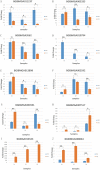Comparative transcriptomes analysis of the wing disc between two silkworm strains with different size of wings
- PMID: 28617839
- PMCID: PMC5472328
- DOI: 10.1371/journal.pone.0179560
Comparative transcriptomes analysis of the wing disc between two silkworm strains with different size of wings
Abstract
Wings of Bombyx mori (B. mori) develop from the primordium, and different B. mori strains have different wing types. In order to identify the key factors influencing B. mori wing development, we chose strains P50 and U11, which are typical for normal wing and minute wing phenotypes, respectively. We dissected the wing disc on the 1st-day of wandering stage (P50D1 and U11D1), 2nd-day of wandering stage (P50D2 and U11D2), and 3rd-day of wandering stage (P50D3 and U11D3). Subsequently, RNA-sequencing (RNA-Seq) was performed on both strains in order to construct their gene expression profiles. P50 exhibited 628 genes differentially expressed to U11, 324 up-regulated genes, and 304 down-regulated genes. Five enriched gene ontology (GO) terms were identified by GO enrichment analysis based on these differentially expressed genes (DEGs). KEGG enrichment analysis results showed that the DEGs were enriched in five pathways; of these, we identified three pathways related to the development of wings. The three pathways include amino sugar and nucleotide sugar metabolism pathway, proteasome signaling pathway, and the Hippo signaling pathway. The representative genes in the enrichment pathways were further verified by quantitative real-time reverse transcription polymerase chain reaction (qRT-PCR). The RNA-Seq and qRT-PCR results were largely consistent with each other. Our results also revealed that the significantly different genes obtained in our study might be involved in the development of the size of B. mori wings. In addition, several KEGG enriched pathways might be involved in the regulation of the pathways of wing formation. These results provide a basis for further research of wing development in B. mori.
Conflict of interest statement
Figures





Similar articles
-
BmSd gene regulates the silkworm wing size by affecting the Hippo pathway.Insect Sci. 2020 Aug;27(4):655-664. doi: 10.1111/1744-7917.12702. Epub 2019 Jul 21. Insect Sci. 2020. PMID: 31225693
-
BmBlimp-1 gene encoding a C2H2 zinc finger protein is required for wing development in the silkworm Bombyx mori.Int J Biol Sci. 2019 Oct 12;15(12):2664-2675. doi: 10.7150/ijbs.34743. eCollection 2019. Int J Biol Sci. 2019. PMID: 31754338 Free PMC article.
-
DIA-based proteome reveals the involvement of cuticular proteins and lipids in the wing structure construction in the silkworm.J Proteomics. 2021 Apr 30;238:104155. doi: 10.1016/j.jprot.2021.104155. Epub 2021 Feb 18. J Proteomics. 2021. PMID: 33610826
-
Transcriptomic analysis of developmental features of Bombyx mori wing disc during metamorphosis.BMC Genomics. 2014 Sep 27;15(1):820. doi: 10.1186/1471-2164-15-820. BMC Genomics. 2014. PMID: 25261999 Free PMC article.
-
The roles of miRNAs in wing imaginal disc development in Drosophila.Biochem Soc Trans. 2012 Aug;40(4):891-5. doi: 10.1042/BST20120035. Biochem Soc Trans. 2012. PMID: 22817754 Review.
Cited by
-
Transcriptome dynamics during metamorphosis of imaginal discs into wings and thoracic dorsum in Apis mellifera castes.BMC Genomics. 2021 Oct 22;22(1):756. doi: 10.1186/s12864-021-08040-z. BMC Genomics. 2021. PMID: 34674639 Free PMC article.
-
A palmitoyltransferase Approximated gene Bm-app regulates wing development in Bombyx mori.Insect Sci. 2020 Feb;27(1):2-13. doi: 10.1111/1744-7917.12629. Epub 2018 Aug 23. Insect Sci. 2020. PMID: 29943911 Free PMC article.
-
Population genomic signatures of the oriental fruit moth related to the Pleistocene climates.Commun Biol. 2022 Feb 17;5(1):142. doi: 10.1038/s42003-022-03097-2. Commun Biol. 2022. PMID: 35177826 Free PMC article.
References
-
- Xia Q, Zhou Z, Lu C, Cheng D, Dai F, Li B, et al. A draft sequence for the genome of the domesticated silkworm (Bombyx mori). Science. 2004;306(5703):1937–40. doi: 10.1126/science.1102210 . - DOI - PubMed
-
- Zhang YL, Xue RY, Cao GL, Zhu YX, Pan ZH, Gong CL. Shotgun proteomic analysis of wing discs from the domesticated silkworm (Bombyx mori) during metamorphosis. Amino acids. 2013;45(5):1231–41. doi: 10.1007/s00726-013-1588-8 . - DOI - PubMed
-
- Dubrovsky EB. Hormonal cross talk in insect development. Trends in endocrinology and metabolism: TEM. 2005;16(1):6–11. doi: 10.1016/j.tem.2004.11.003 . - DOI - PubMed
-
- Thummel CS. Molecular mechanisms of developmental timing in C. elegans and Drosophila. Developmental cell. 2001;1(4):453–65. . - PubMed
-
- Ou J, Deng HM, Zheng SC, Huang LH, Feng QL, Liu L. Transcriptomic analysis of developmental features of Bombyx mori wing disc during metamorphosis. BMC genomics. 2014;15:820 doi: 10.1186/1471-2164-15-820 ; - DOI - PMC - PubMed
Publication types
MeSH terms
LinkOut - more resources
Full Text Sources
Other Literature Sources
Research Materials

